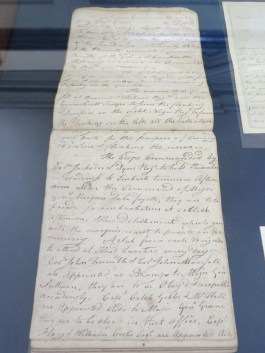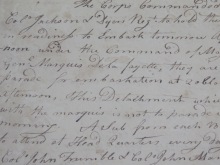Several weeks ago, a Revolutionary War reenactment was held at the Colony House in Newport, RI to welcome the tall ship Hermione.
The date: July 10, 1780. Newport had been occupied by the British for three years since December 1776 until the fall of 1779. The British brought chaos and destruction and over half of the town’s population fled. From July-August 1778 French forces under the command of of the comte d’Estaing attempted to help American troops and planned a siege of Newport from the British. First they miscalculated and then a large storm blew in so the French were forced to retreat. They tried again two years later. On July 11, 1780, the Marquis de Lafayette arrived on the Hermione with 5500 French troops to march with the Comte de Rochambeau.
Reenactors in the guise of townspeople gathered at Newport’s Colony House for a day of events. I tried to aim for the reading of the Town Council Proclamation, but due to getting carsick on the bus, had to sit down in the Visitors’ Center for awhile before walking over to Colony House. (Carsickness also prevented me from taking a water taxi to Fort Adams to see L’Hermione).

 Newport citizens mingled with each other and guests speaking about the Revolutionary War time period in Newport from the perspective of their character.
Newport citizens mingled with each other and guests speaking about the Revolutionary War time period in Newport from the perspective of their character.
 Reproductions of colonial newspapers helped visitors get a feel for what was going on in New England at the time. The articles on the French arrival in Newport are especially fun to read.
Reproductions of colonial newspapers helped visitors get a feel for what was going on in New England at the time. The articles on the French arrival in Newport are especially fun to read.
 The “townspeople” distributed candles to all the guests and led an illuminated procession across the square to the Brick Marketplace gift shop/museum. The candles managed to stay lit despite the ocean breeze.
The “townspeople” distributed candles to all the guests and led an illuminated procession across the square to the Brick Marketplace gift shop/museum. The candles managed to stay lit despite the ocean breeze.
 “Three cheers for King Louis!”
“Three cheers for King Louis!”
In addition to the reenactment, Colony House had a display of archival material and museum pieces relating to the French in Newport. I especially liked seeing the original handwritten documents. It was amazing to read the actual documents that helped contribute to the formation of the United States.
Col. Henry Sherburne’s Military Logbook, 1778 displays an entry from August 8, 1778, the eve of the Battle of Rhode Island. Sherburne was in Tiverton, Rhode Island, the headquarters for the American troops. He recorded the hierarchy of command, including which regiments will be under Lafayette’s control. His handwriting is surprisingly easy to read for a time period when spelling was creative and handwriting vastly different from our own.
The sign states : “This letter describes the movement of the French and American troops and artillery along the York River in June 1782. . . . Writing from Williamsburg, this letter demonstrates Rochambeau’s concern for new defenses at Yorktown and a reinforcement of troops along the seaboard in the event of another British offensive.”
Reproductions of maps from the Library of Congress provide a better idea of what the city looked like in 1780, where the defenses were and where troops were located.

French map showing French squadron entering Newport under battery fire and forcing its way through on Aug. 8, 1778.

French map showing the different operations of the French fleet and American Troops commanded by Major Gen. Sullivan against the English land and sea forces from Aug. 9, 1788 to the night of Aug, 30-31when Americans made their retreat.
Colony House also had an exhibit of items from the Newport Historical Society, such as this silver spoon.
This is a spoon engraved with the Rochambeau crest and presented to Jabez Bowen, the deputy governor of the new state of Rhode Island and his family by Rochambeau to commemorate Rochambeau’s stay in Providence. It look just as beautiful as it must have in 1780. It must have been a great treasure for Mr. Bowen to save and pass down with the wonderful story. (Spoon, Joseph Gabriel Agard (French), ca. 1730-1750. Sterling silver. L. 12-1/4 in. Acquired from Mrs. May H. Bowen, Newport Historical Society1964.3.)
Panel displays also explained more background information. A sign displaying quotations from the diary of Baron Louis de Closen, an aide de camp to Rochambeau, was especially interesting. The Baron noted many differences between French and American manners. He saw Americans as more uncouth than the French, except for the women, of course! The courage of American men is also duly noted, despite their indifferent appearance and more slovenly manners.
Thousands of French soldiers came to occupy the city. Many Newporters were excited to welcome the liberating strangers, but others worried the French would be a repeat of the British – bad guests. Those who were happy about the arrival of the French held an evening illumination in which citizens of Newport put candles in their windows on all the streets leading out of town. These quartering notices inform Newporters of the French occupation.
The French stayed in Newport until 1781. In March 1781, George Washington arrived in Newport and met with General Rochambeau to plot out their next move. Rochambeau and his troops left Newport and met up with Washington and his troops in Yorktown, Virginia, ultimately securing a victory over General Cornwallis and the British. Cornwallis’ surrender at Yorktown marked the beginning of the end of the Revolutionary War.














